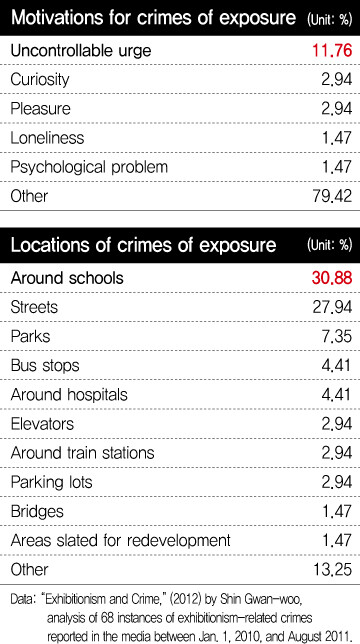hankyoreh
Links to other country sites 다른 나라 사이트 링크
[In-depth report] ‘When I ejaculated on her thigh…she seemed to like it’

By Heo Jae-hyun, staff reporter
Burberry is the name of one of Great Britain’s most famous brands of trenchcoat. Burberry coats are functional items tailored to the country’s often rainy and damp climate. For cool-weather wear, they are remarkably lightweight and practical.Burberry coats have long been sought after in South Korea as a particularly elegant form of men’s wear. But the brand name has also been adopted as part of the local colloquial for flashers. “Burberry men” are males who derive sexual pleasure from exposing their genitals to strangers. One characteristic of a trenchcoat is that it makes it easy for a flasher to walk around with nothing underneath, and simply throw the garment open to instantly expose himself to others. The term “raincoat man”, or flasher, has also been used in some countries.
The issue of flashers, and the fact that they can otherwise be the most ordinary of people, drew renewed attention with a recent indecent exposure case involving Jeju Prosecutors’ Office chief Kim Su-chang, who resigned on Aug. 19. Flashers exist everywhere, and more incidents can be expected in the future. Prevention is an issue that requires systematic research, but South Korean academics have only been exploring paraphilias for around the past five years.
Exhibitionism is just one example of a paraphilia, a term that comes the Greek and roughly translates as “attraction outside the norm,” though it has mainly been used as a biological and medical term for unconventional sexual tastes. As recently as the late 19th century, such symptoms were seen as indicative of an internal ailment. Psychologists later came to view them as a form of sociopathic personal disorder.

Exhibitionism is just one of a long and varied list of sexual disorders recognized by doctors. Others include fetishism, frotteurism, pedophilia, masochism, sadism, transvestic fetishism, and voyeurism. Some research papers number the types in the hundreds. Red flags for possible disorders include powerful, repeated sexual impulses or behaviors performed without another party‘s consent that persist for more than six months.
The recent trend, however, is to avoid classifying all of these conditions as “diseases” requiring “treatment,” regarding them instead as paraphilias or paraphilic disorders. The recently published fifth edition of the “Diagnostic and Statistical Manual of Mental Disorders” (DSM-5), revised for the first time in 20 years, advises that a paraphilic disorder can be diagnosed in cases where an individual “feels personal distress about their interest” or has “a sexual desire or behavior that involves another person’s psychological distress,” which is serious enough to inhibit his or her social functioning.
In other words, if Prosecutor Kim merely had the desire to expose himself, his would have been a simple case of paraphilia. Medical treatment would have only been required if he had suffered or caused distress by acting on his symptoms, or if his impulses had been serious enough to prevent him from functioning socially.
The question on many minds after the Kim case is why people succumb to their paraphilic urges. Why, in other words, does an otherwise normal person - and a socially successful one at that - become a flasher? The short answer is that nobody knows exactly, but many hypotheses and conjectures have been offered.
The British psychologist Brett Kahr’s book “Exhibitionism” has frequently been cited in South Korean papers on paraphilia. It offers some potential psychoanalytic explanations for the phenomenon, including an attempt to enhance masculine prowess as a defense mechanism against castration anxiety (a concept from Sigmund Freud’s development theory holding that boys aged three to five feel sexual desires for their mother and fear that their father might remove their genitals), internal neuroses over psychological trauma suffered during childhood, and a means of restoring lost self-respect.
Another theory from neurobiology holds that paraphilias may result from disorders due to problems in the endocrine system and hormones regulating sexual desire, or from sex chromosome defects. John Money’s “lovemap” theory posits paraphilias as just another variant of the brain activities, common to everyone, directed toward achieving sexual relations with an ideal partner.
According to these explanations, paraphilias can strike anyone from any profession or academic background.
In his 2012 book “Exhibitionism and Crime,” researcher Shin Gwan-woo analyzes 68 instances of exhibitionism-related crimes reported in the media between Jan. 1, 2010, and August 2011, as well as the perpetrators’ occupations. They came from a variety of backgrounds - from high school students to civil servants, university students, self-employed business owners, taxi drivers, company employees, and the unemployed - without any one job class standing out.
Among paraphilias, exhibitionism was also found to occur at a high rate among women. One 2006 by Niklas Langstrom found 32% of exhibitionists in Sweden to be female. It’s not only men who wear raincoats.
Mostly ordinary and mild-mannered in everyday life
One running theme in accounts from acquaintances of people with paraphilic symptoms is how ordinary and mild-mannered they typically seem.
It’s a description that jibes with the account from one South Korean police chief with experience investigating different crimes involving exhibitionism.
“They all end up being very mild-mannered people when you catch them,” the police chief said in an interview with the Hankyoreh. “They also tend to be more fearful than the kinds of sex offenders who assault their victims, since they tend to run away after exposing themselves.”
A public defender who represented a twenty-something man accused of indecent exposure in Changwon, South Gyeongsang Province, similarly described the client as having a “mild, kind, and introverted personality.”
Researchers also said flashers are often prone to rationalization. A 2009 study on rationalization among sex offenders by Dongguk University police administration professor Cho Yoon-oh noted that the offenders have often experienced distortions in their perceptions and misconstrued their sexual advances as welcome.
In 2007, Cho conducted a study of 658 men who were in prison or on probation following a sexual assault conviction. One statistically significant difference was found between the group of 81 men (12.3%) showing paraphilic symptoms and another group of 534 regular sexual offenders (81.2%).
Respondents were asked to choose of five responses to describe the incident for which they were convicted as “not an assault,” “probably not an assault,” “unclear,” “probably an assault,” and “definitely assault.” The average score for the paraphilic group was 22.83 points - statistically significant evidence of lower assault perceptions compared to the 24.85-point average for the regular offender group.
The paraphilic group was also older on average and exhibited more psychological and physical disorders, including depression. Their history of previous sexual assault crimes was found to be more than double that of the regular group, the paper noted, although it did not offer any explanation for the difference.

Testimony of an admitted flasher
I met a seemingly ordinary man who betrays symptoms of paraphilia in order to test the academic theory of paraphilia against this man‘s experience. Of course, it is just one person’s story, but it remains the direct testimony of someone with paraphilia. I hope that will be useful for anyone hoping to understand these people.
The person I met was a 32-year-old man surnamed Kim. He introduced himself as a healthy man weighing 78 kilos and measuring 179 centimeters tall. He graduated with a B.A. in architecture and is currently working at a private architecture firm. He said that he has enjoyed exhibitionism since he was 25 years old and that he has criminally exposed himself more than twenty times so far.
Kim explained that the reason he exposes himself is because of the pleasure he gets from the thrill. “I have a girlfriend. It’s not like I don’t have someone to have sex with. But I get more excited by showing my penis to a woman I don’t know. I really love the unique thrill I get from it,” he said.
However, Kim said that he can’t let his girlfriend find out about his fetish and plans to keep it a secret for his entire life.
Kim said that he generally exposes himself while he is exercising in the park. When a woman passes by in an isolated area, he suddenly pulls his pants down. Outside of the Seoul area, Kim explains, there are few security cameras, and it is easy to avoid the cops. He brings along a bicycle to help him make a quick getaway.
“One time, I was masturbating near a woman who was sitting on a bench. When I was about to come, I ran up to her and ejaculated on her thigh. The woman didn’t seem to be bothered at all. If anything, she seemed to like it. You’d be surprised how many women actually like this kind of thing,” Kim said.
Kim said that he doesn’t think exhibitionism is a medical condition. However, he realizes that it does constitute sexual harassment for his female victims. “It’s true that this is against the law, but I don‘t think it’s a disease. I’d bet that Kim Su-chang doesn’t think it’s a disease, either. He probably promised to get treated so he could get his sentence commuted,” Kim said.
Kim kept showing me pictures of his body as if he wanted to show off his masculinity. Objectively speaking, he had an ordinary physique, but he regarded himself as being pretty buff. Overall he was calm and courteous, but he seemed to get excited when he was talking about something sexual.
Exhibitionists get some pleasure simply by exposing their genitalia, but they get even more from the terror felt by the other person.
It’s important to express your discomfort without losing your cool
From Aug. 2009 until Nov. 2013, a 48-year-old man nicknamed the “squirrel flasher” exposed himself on five separate occasions. One of the police officers who finally apprehended the flasher described his behavior as follows.
“The suspect had stripped naked to take a therapeutic walk in the forest when some women happened to see him. The women screamed and ran away, and at first he was shocked and fled as well. But after he got home and thought about the experience, he realized how nice the feeling had been. After that, he started boldly exposing himself. The more frightened the women were and the more they ran, the more sexual excitement he felt. He said that in the heat of the moment he was unable to control the urge to expose himself,” the officer said.
“If you run into an exhibitionist, you should keep your cool and express your displeasure. If you get frightened, they will like it even more, and if you don’t show you are displeased, they might mistakenly assume that you enjoyed the show,” said Lim Myung-ho, a professor of psychiatry at Dankook University and an authority in research into paraphilia.
Lim also advised victims to report the crime to the police or to tell people they know about it. A rather low percentage of victims of flashers report the incident to the police.
Lim recently carried out a questionnaire of 441 ordinary people in their teens, twenties, and forties. Of the 69 respondents who said that they had been flashed, only 7 (10.1%) had reported the incident to the police.
“Still, more than 80% of the victims told their family and friends about the crime,” Lim noted. “It might help if their loved ones suggested that they report the incident to the police.”
Flashers look for women in their teens and twenties near schools early in the week
Can flashing happen to anyone, anywhere, at any time? The evidence suggests that flashers tend to target women in their teens and twenties (since they are less able to resist) near schools early in the week.
According to a 2012 paper by Shin Gwan-woo titled “Exhibitionism and Crime,” which analyzed 68 cases of crimes related to exhibitionism that were reported in major newspapers between Jan. 1, 2010, and Aug. 2011. 47.06% of crimes occurred in the beginning of the week (Monday, Tuesday, and Wednesday), while only 11.76% of them occurred on the weekend (Saturday and Sunday).
The crimes occurred near schools (30.88%), on the street (27.94%), in parks (7.35%), bus stops (4.41%), and around hospitals (4.41%). 83.83% of the perpetrators were between 20 and 50 years old, while victims tended to be in their teens and twenties (76.47%).
Studies suggest that paraphilia is not a lifelong condition, but it is chronic and lasts for a long time. This is why the recidivism rate is very high for crimes related to paraphilia. If one concludes that their condition has become pathological, it is important to receive medical help, experts say. Recently, courts have begun ordering flashers to complete a treatment program for sexual violence.
In July, a 27-year-old man surnamed Noh was convicted of masturbating in public in front of a middle school girl. He was given a prison term and told to complete one of these programs. Noh had already been been assessed fines in Nov. 2012 and May 2013 for similar crimes. Noh’s first two sentences had not mandated this treatment - and later, he committed the same crime.
“Obviously, people who commit crimes of paraphilia should be punished, but this punishment does not treat their disease. Punishment should be accompanied by appropriate treatment,” Noh’s lawyer said in a telephone interview with the Hankyoreh.
“Patients with paraphilia are receiving treatment to increase their social communication skills, to develop their ability to perceive other people’s emotions, and to control their aggressiveness,” said Lim Myung-ho. Some are also given pharmacologic treatment and operations.
Certain judges argue that the Act on Pharmacologic Treatment of Sex Offenders’ Sexual Impulses and the Medical Treatment and Custody Act ought to be revised so that people convicted of criminal paraphilia can receive counseling for a certain period of time even after they are released from prison or from the National Institute of Forensic Psychiatry.
Please direct questions or comments to [english@hani.co.kr]

Editorial・opinion
![[Column] Has Korea, too, crossed the Rubicon on China? [Column] Has Korea, too, crossed the Rubicon on China?](https://flexible.img.hani.co.kr/flexible/normal/500/300/imgdb/original/2024/0419/9317135153409185.jpg) [Column] Has Korea, too, crossed the Rubicon on China?
[Column] Has Korea, too, crossed the Rubicon on China?![[Correspondent’s column] In Japan’s alliance with US, echoes of its past alliances with UK [Correspondent’s column] In Japan’s alliance with US, echoes of its past alliances with UK](https://flexible.img.hani.co.kr/flexible/normal/500/300/imgdb/original/2024/0419/2317135166563519.jpg) [Correspondent’s column] In Japan’s alliance with US, echoes of its past alliances with UK
[Correspondent’s column] In Japan’s alliance with US, echoes of its past alliances with UK- [Editorial] Does Yoon think the Korean public is wrong?
- [Editorial] As it bolsters its alliance with US, Japan must be accountable for past
- [Guest essay] Amending the Constitution is Yoon’s key to leaving office in public’s good graces
- [Editorial] 10 years on, lessons of Sewol tragedy must never be forgotten
- [Column] A death blow to Korea’s prosecutor politics
- [Correspondent’s column] The US and the end of Japanese pacifism
- [Guest essay] How Korea turned its trainee doctors into monsters
- [Guest essay] As someone who helped forge Seoul-Moscow ties, their status today troubles me
Most viewed articles
- 1[Column] The clock is ticking for Korea’s first lady
- 2[Correspondent’s column] In Japan’s alliance with US, echoes of its past alliances with UK
- 3Samsung barricades office as unionized workers strike for better conditions
- 4After 2 months of delayed, denied medical care, Koreans worry worst may be yet to come
- 5[Column] Has Korea, too, crossed the Rubicon on China?
- 6[Editorial] When the choice is kids or career, Korea will never overcome birth rate woes
- 7Hong Se-hwa, voice for tolerance whose memoir of exile touched a chord, dies at 76
- 8US overtakes China as Korea’s top export market, prompting trade sanction jitters
- 9Constitutional Court rules to disband left-wing Unified Progressive Party
- 10Nearly 1 in 5 N. Korean defectors say they regret coming to S. Korea